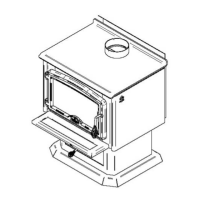Page 25
Installation and Operation Manual - 2000
ENGLISH
North-south loads break down more quickly, but much more wood can be loaded at a time. This
makes north-south loading good for high output, long lasting fires for cold weather.
5. Maintaining Your Wood Heating System
5.1 Stove Maintenance
Your new stove will give many years of reliable service if you use and maintain it correctly.
Some of the internal components of the firebox, such as firebricks, baffles and air tubes, will
wear over time under intense heat. You should always replace defective parts with original
parts. See «Appendix 9: Exploded Diagram and Parts List». Firing each load hot to begin a
cycle as described above will not cause premature deterioration of the stove. However, letting
the stove runs with the air control fully open for the entire burn cycles can cause damage over
time. The hotter you run the stove throughout burn cycles, the more quickly its components will
deteriorate. For that reason, never leave the stove unattended while a new load is being
fired hot.
5.1.1 Cleaning Door Glass
Under normal conditions, your door glass should stay relatively clear. If your firewood is dry
enough and you follow the operating instructions in this manual, a whitish, dusty deposit will
form on the inside of the glass after a week or so of use. This is normal and can be easily
removed when the stove is cool by wiping with a damp cloth or paper towel and then drying.
Never try to clean the glass when the stove is hot.
In spring and fall when the stove runs at lower temperatures, you may see some light brown
stains forming, especially at the lower corners of the glass. This indicates that the fire has been
smoky and some of the smoke has condensed on the glass. When the weather is mild, you
may find that letting the fire go out is better than trying to maintain a continuous fire. Use the
technique described above for building a fire to take the chill off the house.
If you do get brown stains on the glass you can remove them with special cleaners for wood
heater glass doors. Do not use abrasives to clean your stove’s door glass.
The deposits that form on the glass are the best indication of the quality of your fuel and how
well you are doing in operating the stove. Your goal should be clear glass with no brown stains.
If you continue to see brown stains on the glass, something about your fuel and operating
procedure needs to be changed. Stains on the glass indicate incomplete combustion of the
wood, which also means more smoke emissions and faster formation of creosote in the chimney.
If you see brown streaks coming from the edge of the glass, it is time to replace the gasket
around the glass. Visit your stove retailer to get the self-adhesive glass gasket and follow the
instructions below for installation.
Do not abuse the glass door by striking or slamming shut. Do not use the stove if the
glass is broken.
5.1.2 Door Adjustment
In order for your stove to burn at its best efficiency, the door must provide a perfect seal with
the firebox. Therefore, the gasket should be inspected periodically to check for a good seal. The
gasket seal may be improved with a simple latch mechanism adjustment. To adjust:

